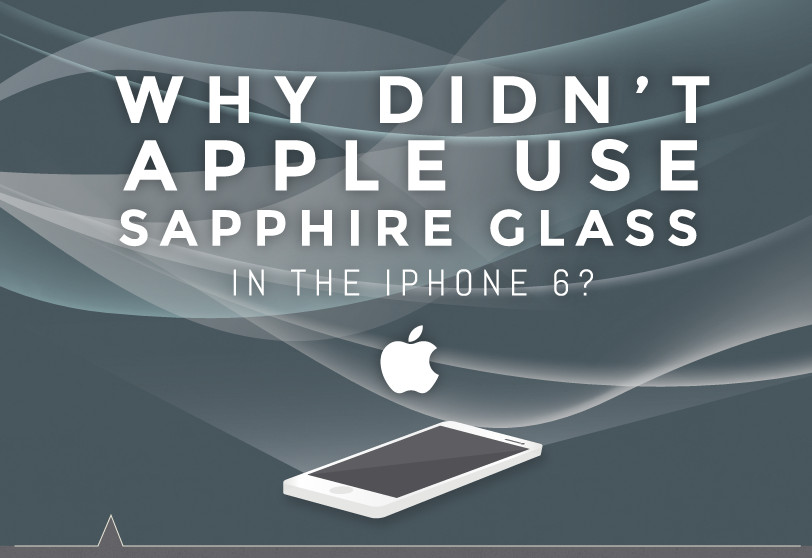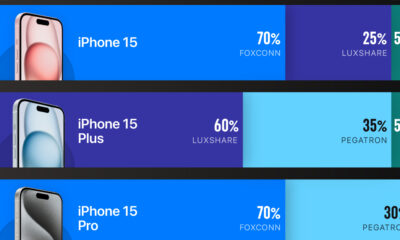Technology
Why Didn’t Apple Use Sapphire Glass in the iPhone 6?

Why Didn’t Apple Use Sapphire Glass in the iPhone 6?
It is a longstanding tradition for the rumour mill to heat up before a highly anticipated Apple product launch. With each event getting more attention than the previous, it is no surprise that sometimes the hype gets out of hand.
This has led to a new tradition: the entire internet griping about which rumours and leaks that Apple was unable to fulfill with their latest product.
The case was no different for the iPhone 6 and iPhone 6 Plus launch yesterday at the Flint Center in Cupertino. Prior to launch, the most persistent buzz about the iPhone 6 was that it would be the first major smartphone to adopt sapphire glass displays rather than use Gorilla Glass, the industry standard.
However, as the launch got closer and closer, it became more and more doubtful that sapphire glass would be used – even despite Apple’s $578 million investment in producing the material. Reports were that the Arizona plant was still slow to ramp up, and it also surfaced that supply chain insiders had not seen enough orders go through.
So why didn’t Apple use sapphire glass in the iPhone 6?
The first reason has to do with the sapphire glass itself. While the material is almost as hard to scratch as a diamond, it turns out that any small impurity in the material can severely compromise its structural integrity. GT Advanced Technologies, the maker that Apple has partnered with, would have had to ramp up production to unprecedented levels while producing flawless material for an estimated 80 million iPhones.
What makes this even more difficult is the way that synthetic sapphires are made. To grow each crystal, aluminum oxide must be heated to 3,700°F in a controlled furnace. Then, the crystal is grown out in a boule and cut with diamond-laced saws. This is a very intricate and involving process, which is much more difficult to ramp up than an industrial scale glass operation such as that of Corning and its Gorilla Glass.
The second big reason that made sapphire glass difficult to integrate within a short timeline is that the economies of scale are not yet there to make the price worthwhile for Apple customers. There are multiple estimates on the price differential, but one estimate puts sapphire as 10x more expensive than Gorilla Glass.
That could be brought down significantly with streamlined production, likely to at least the 3-4x range. In any case, to keep the same margins Apple has, the cost would have to be passed to the customer. Is it worth $100+ to the end user to have more scratch resistant glass?
Maybe some would agree, but Apple believes that it definitely wasn’t worth the risk just yet.
Technology
Ranked: Semiconductor Companies by Industry Revenue Share
Nvidia is coming for Intel’s crown. Samsung is losing ground. AI is transforming the space. We break down revenue for semiconductor companies.
Semiconductor Companies by Industry Revenue Share
This was originally posted on our Voronoi app. Download the app for free on Apple or Android and discover incredible data-driven charts from a variety of trusted sources.
Did you know that some computer chips are now retailing for the price of a new BMW?
As computers invade nearly every sphere of life, so too have the chips that power them, raising the revenues of the businesses dedicated to designing them.
But how did various chipmakers measure against each other last year?
We rank the biggest semiconductor companies by their percentage share of the industry’s revenues in 2023, using data from Omdia research.
Which Chip Company Made the Most Money in 2023?
Market leader and industry-defining veteran Intel still holds the crown for the most revenue in the sector, crossing $50 billion in 2023, or 10% of the broader industry’s topline.
All is not well at Intel, however, with the company’s stock price down over 20% year-to-date after it revealed billion-dollar losses in its foundry business.
| Rank | Company | 2023 Revenue | % of Industry Revenue |
|---|---|---|---|
| 1 | Intel | $51B | 9.4% |
| 2 | NVIDIA | $49B | 9.0% |
| 3 | Samsung Electronics | $44B | 8.1% |
| 4 | Qualcomm | $31B | 5.7% |
| 5 | Broadcom | $28B | 5.2% |
| 6 | SK Hynix | $24B | 4.4% |
| 7 | AMD | $22B | 4.1% |
| 8 | Apple | $19B | 3.4% |
| 9 | Infineon Tech | $17B | 3.2% |
| 10 | STMicroelectronics | $17B | 3.2% |
| 11 | Texas Instruments | $17B | 3.1% |
| 12 | Micron Technology | $16B | 2.9% |
| 13 | MediaTek | $14B | 2.6% |
| 14 | NXP | $13B | 2.4% |
| 15 | Analog Devices | $12B | 2.2% |
| 16 | Renesas Electronics Corporation | $11B | 1.9% |
| 17 | Sony Semiconductor Solutions Corporation | $10B | 1.9% |
| 18 | Microchip Technology | $8B | 1.5% |
| 19 | Onsemi | $8B | 1.4% |
| 20 | KIOXIA Corporation | $7B | 1.3% |
| N/A | Others | $126B | 23.2% |
| N/A | Total | $545B | 100% |
Note: Figures are rounded. Totals and percentages may not sum to 100.
Meanwhile, Nvidia is very close to overtaking Intel, after declaring $49 billion of topline revenue for 2023. This is more than double its 2022 revenue ($21 billion), increasing its share of industry revenues to 9%.
Nvidia’s meteoric rise has gotten a huge thumbs-up from investors. It became a trillion dollar stock last year, and broke the single-day gain record for market capitalization this year.
Other chipmakers haven’t been as successful. Out of the top 20 semiconductor companies by revenue, 12 did not match their 2022 revenues, including big names like Intel, Samsung, and AMD.
The Many Different Types of Chipmakers
All of these companies may belong to the same industry, but they don’t focus on the same niche.
According to Investopedia, there are four major types of chips, depending on their functionality: microprocessors, memory chips, standard chips, and complex systems on a chip.
Nvidia’s core business was once GPUs for computers (graphics processing units), but in recent years this has drastically shifted towards microprocessors for analytics and AI.
These specialized chips seem to be where the majority of growth is occurring within the sector. For example, companies that are largely in the memory segment—Samsung, SK Hynix, and Micron Technology—saw peak revenues in the mid-2010s.
-

 Green2 weeks ago
Green2 weeks agoRanked: Top Countries by Total Forest Loss Since 2001
-

 Travel1 week ago
Travel1 week agoRanked: The World’s Top Flight Routes, by Revenue
-

 Technology1 week ago
Technology1 week agoRanked: Semiconductor Companies by Industry Revenue Share
-

 Money2 weeks ago
Money2 weeks agoWhich States Have the Highest Minimum Wage in America?
-

 Real Estate2 weeks ago
Real Estate2 weeks agoRanked: The Most Valuable Housing Markets in America
-

 Markets2 weeks ago
Markets2 weeks agoCharted: Big Four Market Share by S&P 500 Audits
-

 AI2 weeks ago
AI2 weeks agoThe Stock Performance of U.S. Chipmakers So Far in 2024
-

 Automotive2 weeks ago
Automotive2 weeks agoAlmost Every EV Stock is Down After Q1 2024












